“You’re standing in your bedroom doorway in your underwear in the middle of the night. At the end of a seven-yard hallway, an intruder is holding your son hostage with a knife to his throat. You have a shotgun or a pistol available. Which do you choose? Go!”
I’m on the phone with a former handgun student and good friend. She made the mistake of answering my phone call, and I haven’t even given her time to say hello. She makes a sound—an exasperated laugh of surprise—but she answers.
“Pistol,” she says.
“Why?” I ask.
“Because it’s what I’ve had the most training on.”
Having been her instructor, I know exactly what kind of training she’s had, and how much.
I asked, “At that distance, with your current skill level, do you feel confident you could make that shot on demand with your handgun?”
She hesitates, then answers, “No.”
“Would you take the shot at all?”
“Probably not. No.”
“What if I told you that, with less training, you could consistently and confidently make that shot with buckshot, from a shotgun?”
She scoffed, “I’d say, ‘Show me.’”
Where have all the shotguns gone?
I understood her skepticism. Less than two months ago, I would have shared it.
I had a tendency to turn my nose up at shotguns, feeling that they were a bit antiquated. I thought they were too heavy, unwieldy, inaccurate, had too much recoil, and not enough ammo capacity. Let them fade away into history for all I cared.
When encouraged by a fellow instructor to get shotgun training to make myself a more well-rounded instructor, I whined, “I hate shotguns,” and left it at that.
Fate intervened, however, and I was given the opportunity to spend a day learning defensive shotguns with John Johnston—himself a recent convert to the way of the shotgun. He’d recently taken a couple of shotgun classes and was going through some tests with a Wilson Combat custom Remington 870 and a Beretta 1301. He expressed an interest in getting me behind a shotgun due to my small size of 5’3” and 97lbs. “I have some theories about how you could handle a shotgun,” he said. “If a technique works for you, it will work for anyone.”
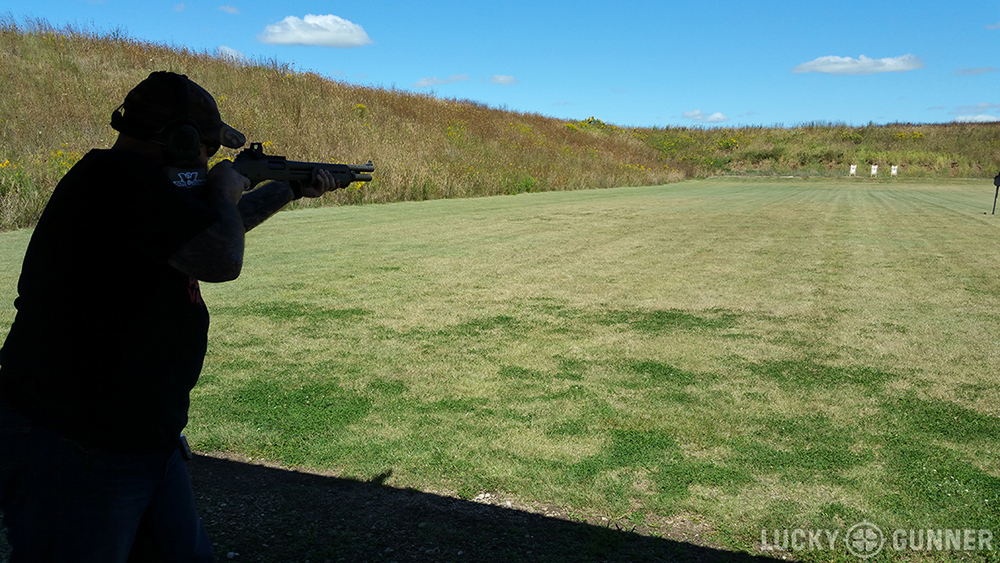
The comment barely registered with me until I was asked if I wanted to contribute to Lucky Gunner’s new series on shotguns. The idea was almost laughable to me, and I shared it with Johnston. “Remember when you said you wanted to get me behind a shotgun? Well, you’re never going guess who they’ve asked to write about them.”
He didn’t laugh. Instead, he made a phone call, and a week later I was on my way to the range with five 12 gauge shotguns and enough ammo to wage a small war, still slightly baffled at my ability to talk myself into some of the strangest predicaments.
As a defensive handgun shooter and instructor, I had no interest in learning the sporting or hunting aspects of the shotgun. While I have nothing against sport shooting or hunting, I’m far more interested in the use of firearms in the context of defense. Now, I was getting that chance.
I was determined to welcome the experience and learn what I could. Would my bias be changed, or would I leave still indifferent toward shotguns? I wanted to know what I didn’t know (which I suspected was a lot), and give the shotgun a chance to win me over.
Eight hours later, I walked away feeling a little guilty. I had been wrong—so wrong. And now I wanted to go out and get myself a shotgun. I wanted to set it up, train with it, and put it beside my bed or my back door, or both, forever replacing my handgun as my primary home defense gun.
To complete my experience, John put me in touch with Steve Fisher, who is not only a delight to talk to but also one of the few remaining expert defensive shotgun instructors. We discussed some of the reasons shotguns are underutilized and misunderstood; namely, poor experiences, lack of training, folklore, and the rise of the carbine. We also talked about what we can be done to start turning these attitudes around.
Fitting the Defensive Shotgun
I remember the first time I fired a shotgun. It was my father’s double-barrel over/under that sat in his bedroom for home defense. It was heavy. I was young. His advice was to hold it as tightly against my shoulder as possible, and were it not for his chest pressed against my back, my next view after I pulled the trigger would have been the blue sky. It left a good bruise and little desire to repeat the experience. Even as an adult with four shotguns in my safe, I couldn’t remember the last time I purposely allowed any of them to see the light of day.

Even among the biggest and strongest, it’s no secret that the shotgun is a heavy-recoiling gun. Bruised shoulders and sore arms can leave the prospect of wielding a shotgun a daunting task. Lighter and less violent carbines and handguns just seem so much easier on the body, causing shotguns to be set aside.
“Sure, a 12-gauge is a very violent gun to people who aren’t willing or haven’t been properly trained in its use,” Fisher said. “But [that] can be mitigated with a few simple remedies… And it doesn’t always have to be a 12-gauge.”
For women or men, upper body strength and mass can have an impact on their ability to control a shotgun.
“Most people—even adult males—would be well-suited by using a 20-gauge shotgun versus a 12,” Fisher said. “The 12-gauge is known as an awesome man stopper, which is absolutely true, but even in a 20-gauge, 00 buckshot is still 00 buckshot.”
The smaller gauge helps to mitigate the recoil and aide in better control, allowing for more positive experiences. “I have a 20-gauge shotgun lying around and I’m 6’4”, 300 pounds,” said Fisher. “They are lightweight. They are more portable. They are easier to maneuver around than a larger, heavier 12-gauge on the same frame. The options are there to go from a 12-gauge to a 20-gauge with the same devastating effect that the 12-gauge has, with less punishment [to the shooter].”
It can also help to learn how to fit a shotgun to its intended user. None of the shotguns we shot during our range trip were actually set up for me, and John kept telling me that if they were, I would have had an even better experience. I asked Steve what’s involved in fitting a shotgun.
“First thing I would look at is the size of the shooter,” he said, explaining that length of pull — the distance from the trigger to the rear of the stock — are commonly too long, even for larger individuals.
“Pretty much every shotgun made, pump or semi-auto, that comes off the shelf outside of the Beretta 1301 — even the youth stock model guns that Remington or Mossberg sell — a lot of times, are still too long. The average length of pull should be about 12 ½ to 12 ¾ inches.
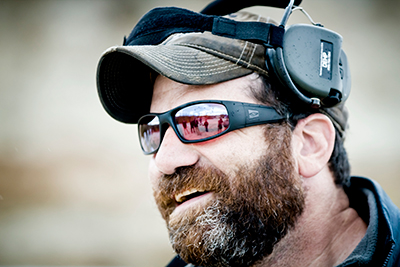
Steve explained that the current average is about an inch to two inches longer than that. I asked him why the industry doesn’t start cutting them back if they are too long.
“Because they don’t care. They sell millions of them, and most people are too ignorant to that fact,” he said.
When considering a setup for someone as petite as myself, Steve said that after finding the shortest stock available, I would be best served sticking to the minimal legal barrel length. He also suggested I stick with a standard magazine tube length versus an extended tube, in order to keep the gun from becoming too front heavy. The shorter tube increases leverage and ability to maneuver the gun.
Anticipating push back on lowering the shotgun’s already minimal capacity, Fisher explained, “Nothing says you have to have an eight-shot capacity gun. I haven’t seen any factual data that has shown me where someone has used all eight rounds in that gun in a civilian engagement in their homes… If you do the research on the data you will find that it has probably been no more than a maximum of three rounds ever fired. Most times, two.”
Considering the number of pellets being launched with 00 (usually eight or nine pellets), #1 (15 pellets), or even #4 buckshot (approximately 24), one cannot claim three shots from a shotgun to be inadequate.
The additional aspects of setting up a defensive shotgun were less about size and more about optimizing the firearm for use in a defensive engagement; accessories like a white light, a night-sight front bead or red dot, and some means to carry spare ammunition on the gun.
“I can always pick up a gun that’s set up for you and use it,” Fisher said, “You would not be able to pick up a gun that is necessarily set up for me and use it because the length of pull, but there are ways to teach that as well, but that’s a training issue.”
Finding a shotgun course
One of the first things John pointed out to me when we got on the range was that I’d been taught to shoulder the shotgun incorrectly. Despite every shotgun we had with us being too long for me, I was still able to run them well utilizing what is referred to as the “push/pull” technique. Gripping the forearm with my support hand, John told me to push that out toward the target while I pulled back with my firing hand. “Like you’re trying to pull it in half,” he would say and I was amazed at how much more manageable the recoil became, even in such a heavy-recoiling gun.
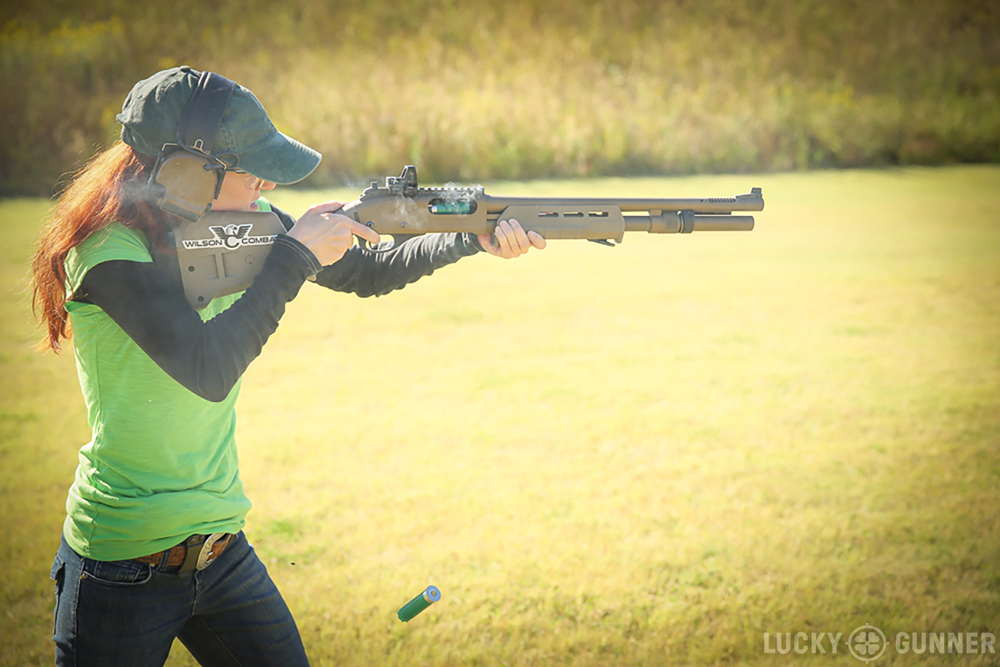
In addition to the push/pull, John worked on my stance, ready positions, and basic maneuvers that made even the larger shotguns relatively easy to shoot, and I had a more pleasant time than I imagined I would. I preferred the semi-auto to the pump due to shoulder fatigue, but I left the range without any pain or bruising in my shoulder pocket. A vast improvement over my last time out with a shotgun.
Before that range trip, shotgun training was something I’d never considered. Worse, I wouldn’t have even known where to look. A Google search for my area resulted in a few hunting or sporting classes, but nothing for defense or tactics. I suspect my experience is not unique. Many others would find the same results searching in their own areas. There simply isn’t a big demand for defensive shotgun training, so finding a quality class can be challenging.
I asked Fisher what consumers should look for in a defensive shotgun instructor.
“Look at their course curriculum,” he said. “You need to find someone who will help you choose and pattern a load of buckshot for your gun…give you multiple reps of manipulations on the gun, [teach you] how to mitigate the recoil, and that’s it.”
He cautioned against course descriptions that had people going out to 100 yards or doing slug change overs, or other fancy manipulations, because that’s not what most people need. The majority of defensive shotguns are purchased for defense of the home, where distances will be relatively close.
Shotgun folklore and misconceptions
Perhaps the reason there is a lack of demand for good shotgun training is because of the abundance of misinformation surrounding the shotgun, how it’s used, its capabilities, limitations, and context.
Within a single conversation over any gun store counter in America, you will hear advice ranging from, “They’re easy. You don’t even have to aim them,” to “They’re terrible! You’ll kill everything in your house and the next house, too.”
I asked Steve if he thought these misconceptions were due to ignorance regarding the advances in ammunition, and he emphatically agreed.
“I think where that comes from is a lot of the misconceptions based on people’s lack of knowledge or willingness to go out and actually pattern the gun and see what the gun will do with specific loads,” Fisher said.
He explained that, for years, buckshot was notorious for its inaccuracy because of the wide patterns it produced.
“Today’s modern ammunition has given the shotgun the ability to be surgical to approximately 15 yards,” he said.
I suppressed my desire to interrupt him with quotes from Kill Bill, allowing him to continue, “When you take the average home distance encounter… the average is seven to ten yards, max. So, by having today’s modern ammunition, it’s not necessarily the hallway, street-sweeper gun that is going to throw a spread of 15 to 20 inches at fifteen yards.”
This was reflected in my own recent experience. To illustrate the accuracy potential of buckshot, John had started our range session at 100 yards. Of the eight 00 pellets we sent down range, two of them hit the target. As we moved closer to the target, as far away as twenty-five yards we were getting all shots on the chest of a man-sized target, using Federal Tactical with the Flite Control wad. At fifteen yards, we were able to make consistent hostage rescue shots without a single pellet deviating to the side of the target we determined to be our hostage. We tried to replicate that with our handguns on the other side of the target, and, honestly, our hostage may have not survived all of the shots we took.

To say my previous opinions about shotgun accuracy were outdated would be an understatement.
Another myth that had been relayed to me was that shotguns are more difficult to manipulate than other self-defense tools. Due to my limited experience with them, I wasn’t sure if this was true or not, but my time on the range with them did not seem to support that idea. I asked Steve about it.
“No. That’s false,” he said. “If you’re running a pump, you press the trigger, you run the slide action bars to the rear, you follow it all the way forward, you do it very violently, very aggressively, the gun fires again. I won’t say that’s a difficult task.”
In case someone were to argue that point, Steve offered an alternative. “When you look at a revolver or a handgun, you press a trigger repeatedly, the gun goes off, so why not just get a semi-auto shotgun?”
Answering his own question, he went on to explain yet another myth — that pump actions are more reliable than autos. “A lot of people used to spill that out as kind of a myth because pump guns were the most durable, reliable. You could hand-cycle them. They will feed any load you give them. So a lot of that, again, was based upon ammunition,” Fisher said. Many of today’s semi-auto shotgun designs are not nearly as ammunition-sensitive as older models.
Another commonly debated aspect of defensive shotguns is the classic problem of over-penetration. Some insist that buckshot easily penetrates through walls, meaning stray pellets could potentially endanger innocent lives inside the home, or even in neighboring homes. An often-repeated workaround is to load the home defense shotgun with less effective birdshot. However, Fisher is not a fan of this solution. “Having fired a lot of shotgun rounds inside of houses and structures, birdshot will still pass through walls and have a degree of lethality. So does buckshot.”
Even taking the worst case scenario of a complete miss and penetration through the exterior wall of your own home, Steve explained that the pellets would most-likely no longer have the energy to penetrate the exterior of a neighboring building to make it to the interior.
Steve relayed a test he performed in abandoned, but still-intact houses. “I shot a round of 00 buck inside a house, average bedroom distance. [I] shot it into a wall. One pellet of 00 buck penetrated and the house next door—basically a driveway width apart—it hit the exterior window and cracked it but did not penetrate it.”
I circled back around to the potential for misses being more of a training issue, and Steve agreed. Finding good angles that would mitigate the risks of errant rounds causing damage is something to identify before the bad guy is standing in your hallway.
Steve was quick to point out that advantageous positioning would be ideal, but it’s not always possible. “Nothing in the gunfighting rule book says that you can’t take a knee, shoot at an upward angle and blow the top of their head off through the base of their jaw. Nothing says you can’t lower the shot angle, shoot then in the pelvic girdle, shoot them in the legs and take them down to a lower level, and then finish them off with another round. That’s something you might not be able to do with a pistol, at least accuracy wise, for a lot of people. But with the sheer devastation of a shotgun you have bone-crushing ability to literally take away mobility.”
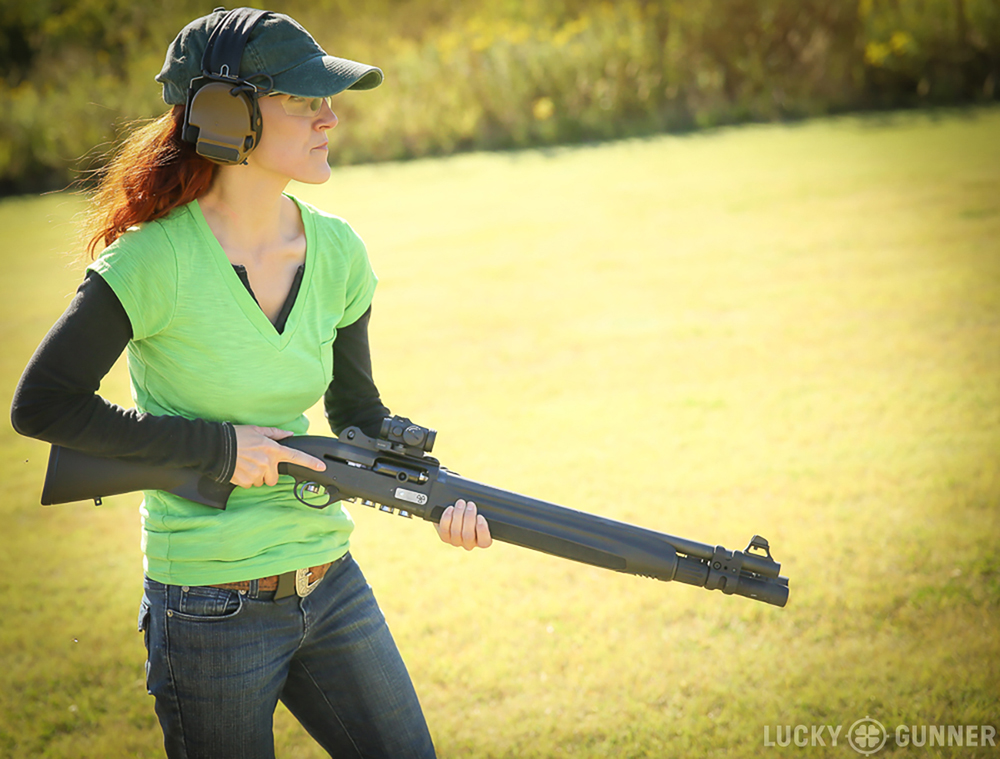
“So, again, a training issue,” says Steve, “understanding angles of fire and setting up a home for home defense.”
I considered the two and three-inch patterns John and I got on the range at seven to ten yards. For a low-angle shot to the legs, that would still require significant accuracy. I mentioned that to Steve.
“Yes!” he said. “This is a problem that most people have with shotguns. Everybody wants that tight pattern. There is such a thing as too tight of a pattern on a house gun.” This was particularly true when discussing the ability to hit moving targets while also moving.
“I look for a shot pattern that will give me approximately four inches to six inches of pattern at the maximum distance I perceive that my engagement will occur… The shotgun gets its power—its control measure—from the density of its pattern, from its spread.”
John Johnston didn’t necessarily agree. He cited his desire to have as much precision as possible as his reason for choosing ammunition that produced far tighter patterns at those in-home distances than the four to six inches Steve likes to see. However, Johnston was quick to point out that he’s “no Steve Fisher”, and that Fisher’s opinion should carry more weight than his own. No matter who you agree with, however, the shotgun and modern ammunition gives you the ability to have either precision or spread, provided you go out and actually test your shotgun and your load and know what it will do at your most likely engagement distances with your gun.
The rise of the carbine and the case for the shotgun
There was a time when a shotgun could be found in most police cruisers the country over. Over the past twenty years or so they’ve slowly given way to a lighter, higher-capacity, gentler-recoiling, and more accurate long gun; the 5.56 carbine.
“You have a lot of guys coming out of law enforcement or current military backgrounds where all they ever knew was carbines,” Steve told me. “Departments started taking shotguns out of use and starting going strictly to carbines. So it’s kind of a natural progression.”
That doesn’t necessarily make a carbine a poor choice for home defense. Steve was quick to defend the carbine, but he remained an advocate for the shotgun.
“When I have to fire and solve an equation immediately with the maximum amount of lethality that I can get with one press of the trigger versus, say, three to five, why wouldn’t I choose that which would give me less time in the fight, therefore increasing my chances of survivability?”
I remembered being impressed with that same principle on the range when, at 25 yards, Johnston asked me to draw my handgun and get a good hit on target. I drew and put one round, center mass in about two seconds.
He handed me the Beretta 1301 and told me to do the same thing. In less time than it took me to draw and fire a 9mm I put eight .33 caliber pellets into the chest box of the target, and his point was made without much need for further explanation.
Nothing but a shotgun can deliver so many projectiles that quickly and accurately.
The Federal Flite Control shells produced extreme accuracy at home defense distances, but if that’s not what people want, Steve recommended looking into three or four different types of ammunition, starting with Remington and Federal in 00, #1, or #4 buckshot. He recommended finding the best load that provides the most consistent pattern at the maximum distance you expect to use the shotgun. When you’ve identified a potential candidate, he suggested trying out that load on a target that simulates a person standing sideways to determine the consistency of multiple shot patterns on target. “Multiple hit capability with more projectiles is really where the shotgun does its magic,” he said, and I couldn’t agree more.
Spending actual time on a range with even the most minimal instruction was enough to show me just how wrong I was about shotguns and their capabilities. I learned so much about how to use them and work them and, even today, I shared with my husband that a 20 gauge (or maybe a 12) is somewhere in my future, probably in conjunction with a class with Steve Fisher or Tom Givens. Even without the benefit of a class, shotgun owners can still learn a lot about what their guns are capable of with some simple experimentation on the range with different loads.
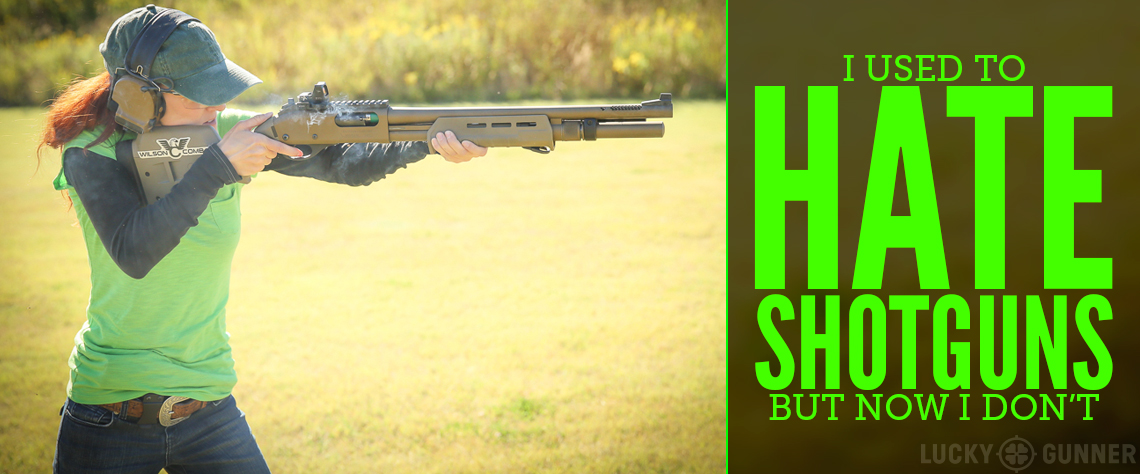


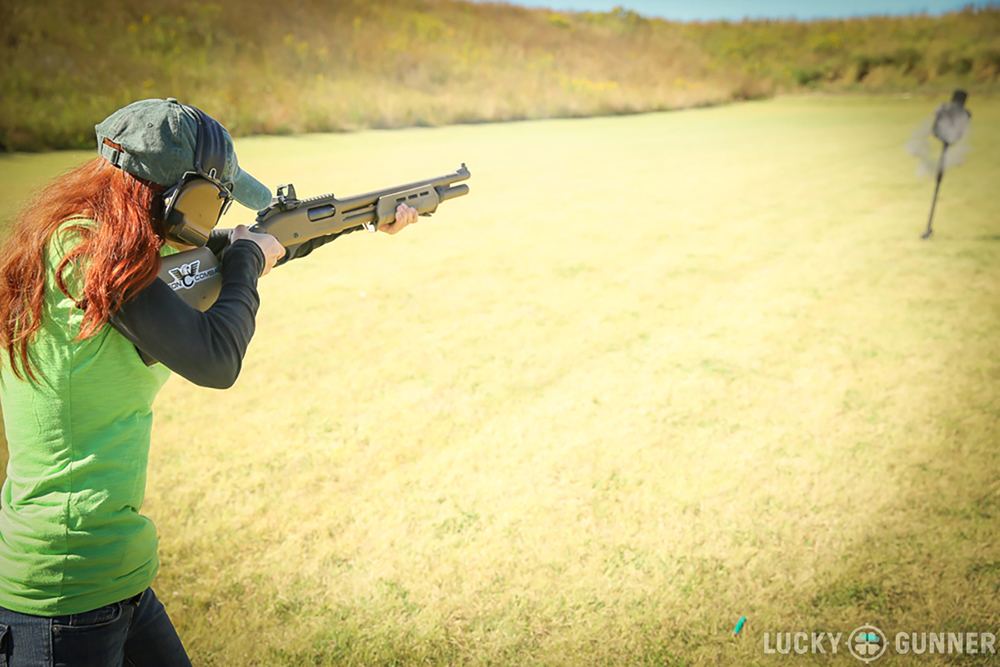
Great article. Thanks.
EXCELLENT article.
Now to go look at shotguns.
I keep shotguns in my house for the reasons stated..When there’s a bump in the night I grab my Baikal sxs w/light attached. But there are plenty of Glock .45acps handy also. And yes, a 20 gage is good enough unless your in bear country.
1301 Tactical FTW! Mine is by my bed at all times, gassed up and ready to roll. Excellent knowledge being spilled here.
I have a range of defensive pump shotguns and now that I think about it, I probably should have just picked one and spent the money to have it Vang Comped and/or worked over by Scattergun Tech. I’ve always wanted a semi-auto but cost has been a factor. (Again, if I hadn’t bought so many pumps…)
Anyway, a very well-written article. Thanks.
I live in a rural area. The neighbor’s house isn’t a concern. I load slugs. It’s going right where I want it and NOBODY is getting back up after taking a 1 oz hollowpoint.
“even in a 20-gauge, 00 buckshot is still 00 buckshot.” True, but you’re not gonna find much 20 ga. 00 buckshot.
Wal-Mart has 20 gauge 00 buck shot. It is widely available.
Can you post a link to that product please?
That’s true, but it does exist. You need to look for it online. I can think offhand of two companies that manufacture 20 gauge, 8 pellet #00 buckshot ammunition.
Paraklese Technologies
No Man’s Land
Yes, the big fat .33 caliber pellets do stack a little bit crooked inside the 20 gauge hull–but the bad guy isn’t going to be able to tell the difference.
There’s also 9 pellet #1 buckshot from Rio.
i was enjoying the article up to the bit about her being in her underwear – see thru French knickers, or a thong. i need to get the image clear in my mind.
I kind of want a 5-8 shot 20 gauge with a decent red dot on it for hog and house. Hmm fun.
Really helpful article.
Anybody recognize the middle shotgun in the photo of five? Looks familiar, but I can’t place it.
My ‘House / Camp’ 870 Build.
I’m afraid my old 20 gage pump field model will have to be replaced. Good info—keep it up…
The S&W governor is a shotgun in a handgun package. While I love my shotguns, that will always be my home defense choice.
For your own safety, please reconsider. 410 is a poor choice for stopping human attackers, and even worse at the velocities achieved from a handgun barrel.
Which gun do you recommend for at home protection? Thanks.
My 12 ga., Mossberg 500 Persuader fitted with a Blackhawk pistol grip stock and ghost ring sights is perfect for home defense. I also have several semi-auto pistols and .38/.357 revolvers strategically hidden around the house in case I can’t get to my shotgun. I’ll have to check out some of the new 00 ammo.
Great article.
great article,I did not see what choke were you using, or did I just miss it?
I believe all the shotguns used in the article have a cylinder bore.
heh. I just tried a pistol grip 12 gauge this weekend.
Screw that, never again. Couldn’t hit crap, and my hand felt like it got stepped on by a horse. I do want one with a buttstock though
Yep, me too! I can hit mostly anything within 10 yards with it but going to the range is no fun. And bracing against my side or stomach just means additional bruising. But, for home defense, where I need only 4-5-6 rounds, it’s just fine. I load buck, buck, slug, buck, slug, slug. I also keep one with a stock in the house.
a test conducted by this website verified that stock-less pistol grip shotguns are abyssmal and uterly useless, at least in comparison to stocked shotguns
So did I read the implication correctly that the for a 7-yard Hostage-Rescue shot a shotgun would be the better choice than a pistol? Really? Does anyone else see the fallacy in this? Has anyone seen what a shotgun wad can do at 7-yards?
While a Hostage-Rescue shot is never something I would ever want to try, but I would rather attempt it using a firearm that only discharges a single projectile versus one that does to with 2 or more, especially when 1 of those do not follow a specific flight path!!
I don’t know about you, but I certainly hope that my local LE Agency’s Tactical Team does not think a shotgun is the best tool for such a precision shot if I am ever held hostage. And I don’t care how much training they’re had with the shotgun!!
The wad in Federal Flitecontrol 12 gauge loads stays with the pellets out to about 10 yards. One hole. And no one is suggesting this would be the appropriate tool for a coordinated LE hostage rescue attempt.
“fifteen to twenty inch patterns at 15 yards” Pardon me? I have an old Remington 870 “Express HD” gun with the 18″ cylinder bore barrel.
Granted, I have not had the opportunity to pattern it with a lot of different ammo types. The indoor ranges in this area tend not to want people to bring in shotguns. But my worst 15 yard patterns were 12″ or so and many were better, using Estate Cartridge 27 pellet #4 buckshot and “Rio” brand 9 pellet #00.
Looks awesome!
Thanks Guy, have yet to see if it will cycle “low Recoil” yet. The hollow stock made it real nose heavy, so I used foam in a can to fill it and sprinkled #8 shot in between layers to balance it out better 🙂
I love shotguns, and my go-to is a Saiga 12 with a powerful light on it that resides in one of those nifty mattress mounted horizontal racks on the bed. But if someone had my wife in a hostage hold (not a very likely situation, but anything is possible), I’d take the shot with my Glock and she would want me to.
I like a handgun for concealment and portability, but nothing puts lead on the target like a shotgun. Nothing says, “Hey fella, you’re in the wrong place,” like the business end of a twelve gauge.
https://uploads.disquscdn.com/images/dd5cf48d2e78f814b913549b3852624d71fa2084239c066b72d847c81d313292.jpg https://uploads.disquscdn.com/images/e0d1b45021542bb2ab1d89492f5a28192194a673c458ff22c1d2332bfdfeca41.jpg
Just because.
https://uploads.disquscdn.com/images/c9dc258450105fbd6b6eae7f03fb2ec40d2ff1ec31cbf25b5901d2f5fda336aa.jpg https://uploads.disquscdn.com/images/2a6fd202c14000948412ceadbb856113ebf99cd9367f401c942cfda562aa3437.jpg